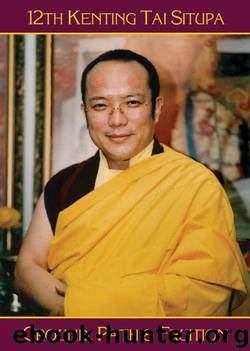Ground, Path, and Fruition by Tai Situpa Chamgon Kenting

Author:Tai Situpa, Chamgon Kenting
Language: eng
Format: azw3
Tags: Mahamudra (Tantric rite), Dharma (Buddhism)
Publisher: Palpung Zhyisil Chokyi Ghatsal Publications
Published: 2011-07-08T03:00:00+00:00
4: SHOWING THE UTILIZATION OF PRACTICE IN ONE’S WHOLE LIFE
The Paramita of Diligence
Practice the five strengths,
The condensed heart instructions.
The Mahayana instruction for ejection of consciousness at death
Is the five strengths: how you conduct yourself is important.
This is explained as the five strengths in two different situations: while we are living and when we are dying.
Living: The first strength is bodhichitta itself. Its strength is similar to the force with which we hit a golf ball: the first drive sends the ball where we want it to go. In Tibetan it is called the penpä tob: penpä means throwing, tob means strength. The strength with which you throw something is what makes it reach its destination. If we wish to end up as Buddhas, we have to have the strength to project ourselves in that direction right from the beginning. This strength is bodhichitta. It is the thought, “I wish to become a Buddha so I can lead all sentient beings to Buddhahood.” This is our driving force, our first strength.
The second strength is our constant practice of relative and ultimate bodhichitta. In Tibetan we call it the kom bä tob. Kom bä means to acquaint ourselves with something, to get used to it, so this refers to practice itself. It refers to getting used to bodhichitta.
The third strength is the kar bö sabön tob. A sabön is a flower’s seed and kar bö means white. This means we should always do our best to encourage relative and ultimate bodhichitta, to let them manifest from us and continue to grow like a planted seed. Our bodhichitta should progress from a shoot to a bush, to a flower and finally to fruit. If relative and ultimate bodhichitta are constantly cultivated and practiced they will flourish like this and come to fruition.
The fourth strength is the sunjinpä tob. Sunjinpä means to defeat. We do not have to defeat anyone outside ourselves though, just our egos. It is our ego that harms us so we have to do our best to achieve victory over it. Our ego manifests, as I have said many times, as attachment, greed, anger, jealousy, pride and so on. If we cut the supplies to our attachment, jealousy, anger, then we can defeat our ego. After all, the essence of our ego is primordial wisdom, so when our ego is defeated it will transform into primordial wisdom. It is not as if our ego is our number one enemy, because it is actually the other side of our perfect essence, but when we do not know this, that is ignorance, and a by-product of this ignorance is the ego.
Ignorance, ego, the “I,” duality are all different names for the same thing. Doing our best to minimize its negative aspects is the fourth strength. We need to do this to the best of our capabilities even when we are just beginning to practice. We need confidence at the beginning though, and if we desperately do away with our entire ego we may also lose our confidence.
Download
This site does not store any files on its server. We only index and link to content provided by other sites. Please contact the content providers to delete copyright contents if any and email us, we'll remove relevant links or contents immediately.
| Acupuncture & Acupressure | Aromatherapy |
| Ayurveda | Chelation |
| Chinese Medicine | Energy Healing |
| Healing | Herbal Remedies |
| Holistic | Homeopathy |
| Hypnotherapy | Massage |
| Meditation | Naturopathy |
| Reference |
Inner Engineering: A Yogi's Guide to Joy by Sadhguru(6728)
The Power of Now: A Guide to Spiritual Enlightenment by Eckhart Tolle(5610)
Fear by Osho(4663)
Ikigai by Héctor García & Francesc Miralles(4125)
The Art of Happiness by The Dalai Lama(4065)
The Ultimate Bodybuilding Cookbook by Kendall Lou Schmidt(3886)
Yoga Therapy by Mark Stephens(3705)
The Little Book of Hygge by Meik Wiking(3648)
The Healing Self by Deepak Chopra(3478)
Why Buddhism is True by Robert Wright(3405)
The Hatha Yoga Pradipika (Translated) by Svatmarama(3237)
Being Aware of Being Aware by Rupert Spira(3231)
Shift into Freedom by Loch Kelly(3139)
Wild Words from Wild Women by Stephens Autumn(3095)
Work Clean by Dan Charnas(3055)
Happiness by Matthieu Ricard(2996)
More Language of Letting Go: 366 New Daily Meditations by Melody Beattie(2972)
Yoga Body & Mind Handbook by Jasmine Tarkeshi(2836)
Why I Am Not a Feminist by Jessa Crispin(2697)
